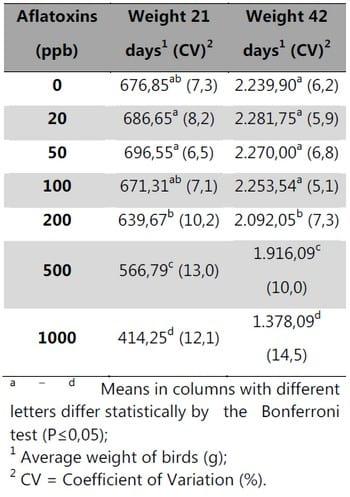Mycotoxins and Poultry
Mycotoxins Problems in Poultry
Mycotoxins are contaminants of many cereals and derivatives used as ingredients in poultry diets. They are considered secondary metabolites produced by fungi that develop well in tropical climates. When they are present in moderate to high concentrations in the diet, it might result in death, and when used in low doses, it may compromise production indexes, such as decrease in weight gain, poor feed conversion, decline in egg production and decrease in hatching rate. The management and control of mycotoxins are essential to reduce their harmful effects. These are two important processes that must be thoroughly conducted, since mycotoxins may provide great economic losses in poultry business. The monitoring and using AntiMycotoxins Additives (AMA) are good examples for solutions.
1. MYCOTOXINS OF MAJOR IMPORTANCE IN POULTRY
Mycotoxins are toxic substances resulting from the secondary metabolism of several strains of fungi filamentous. They are organic compounds, with low molecular weight and they have no immunogenicity. The fungi grow and proliferate well in cereals, especially maize, wheat, sorghum, in where they generally find a highly nutritious substrate for their development. The fungal growth and mycotoxin production in cereals may occur at different stages of development, maturation, harvesting, transporting, processing or storage of grain. Therefore, the reduction of grain moisture by drying is of fundamental importance to reduce the levels of contamination (MALLMANN & DILKIN, 2007). In Table 1, mycotoxins of greatest impact on poultry production are related, in addition to the fungi that produce them and the conditions that favor the formation of such compounds.
1.1. Aflatoxins
Aflatoxins are secondary metabolites produced by fungi of the genus Aspergillus, especially A. flavus and A. parasiticus, they were discovered in the 1960s, after provoking an outbreak (Turkey X disease) with high mortality of turkeys in England (MALLMANN & DILKIN, 2007). In this outbreak, thousands of birds have died after consuming food containing peanut pie. The main fungus found in peanut meal was Aspergillus flavus, giving its name to this toxin.
In outbreaks of aflatoxicosis, one of the most important features is the poor absorption of food that is manifested by the presence of poorly digested food particles in the feces of birds. It is associated with steatorrhea or increased excretion of lipids. This can be severe with an increase of up to ten times of fat content in feces. In broilers, the steatorrhea is accompanied by a decrease in total and specific activities of pancreatic lipase, the main digestive enzyme from fat and a decrease of bile salts, necessary both for digestion and for absorption of fat, leading to hepatic steatosis (fatty liver). Mucosal pallor and legs is also observed in chickens and hens receiving feed contaminated with aflatoxins. This seems to be a deficient pigmentation result of reduced absorption, transport and decreased tissue deposition of carotenoids in the diet, and the aflatoxicosis identified as "pale bird syndrome".
The sensitivity to the toxic effects of aflatoxins varies considerably among different animal species, even among individuals within a species; the dose-response relationship may vary according to race, sex, age, immunity, diet composition, among other factors. For many species, males are more susceptible than females, whereas, in general, sensitivity is markedly higher in young than in adults (Leeson et al., 1995).
1.1.1. Effect of aflatoxin on laying hens
The presentation of the disorders caused by aflatoxin on egg production is only possible after a few days or weeks. The presence of pre-ovulatory follicles already formed, in the reproductive tract of the birds prior to consumption of mycotoxin justifies this late response. The decrease in egg production is preceded by a reduction in blood levels of proteins and lipids. Hens consuming diets containing aflatoxins 5 ppm for 4 weeks, may show a reduction in egg production from the eighth day, reaching a decrease in production of around 35%, one week after removal of the mycotoxin diet (ROSA et al., 2001).
Besides reducing the production of eggs, aflatoxicosis also induces a reduction in egg size, as well as the proportional reduction in the size of the yolk, due to the damage caused in the lipid and protein synthesis. However, the deposition of calcium in the eggshell is normal. Thus, the egg gets smaller due to the decreased egg white and yolk and the shell becomes thicker. Thus, the resistance increases and the shell can affect the hatchability for the reduction in gas exchange between the embryo and the environment.
Embryo mortality with eggs intoxicated with aflatoxins happens because these substances, after being biotransformed in the liver, have as one of the major metabolites, aflatoxin M1, which is eliminated from the body through the yolk. Moreover, aflatoxin B1 and aflatoxicol can also be found in the yolk, from 24 hours after ingestion of aflatoxins.
Aflatoxin B1 can contaminate both the yolk and the egg white. Trucksses et al. (1983) found aflatoxicol and aflatoxins B1 and M1 in eggs 24 hours after consumption of contaminated feed. Therefore, it must be noted that while the rate of posture is affected only 8 days after onset of intoxication, hatchability begins to be affected 24 hours after consumption. Aflatoxins can enter the egg at any stage of its development. For an oocyte to develop into a mature egg, it takes 7 to 8 days and 24 hours more to complete the process of formation of the egg, and then, this is the necessary time since the contamination until the detection of aflatoxins in the egg.
1.1.2. Effect of aflatoxin on the production of turkeys
Throughout the past few years, Brazil has achieved significant increases in production and export of meat and poultry products. In this context, it has great importance to turkey production. Turkeys are more susceptible to the effects of aflatoxin than broilers, without identifying the real impact of these mycotoxins in the development of these birds.
1.1.3. Effect of aflatoxin on the performance of different strains of broiler chickens
1.2. Cyclopiazonic acid
Oral lesions caused by the contamination with DAS become necrosis of the tip of the tongue, especially in commercial breeders and laying hens, and can rarely be found in broilers. However, the lesions found in cases of contamination by T-2 toxin, commonly are erosion and/or ulcers of the palate and the commissure of the beak of birds contaminated. These lesions can be evidenced in both breeder hens and in broilers. However, similar studies performed with DON, have clarified that with the exception of a transient decrease in hemoglobin, or a very slight effect on egg quality, there is significant evidence that this toxin affects the performance of birds. They are able to tolerate relatively high concentrations of DON in the diet and a little less than the T-2 toxin and DAS. The DON levels normally found in contaminated feed (0.35 to 8.0 ppm), no indications of any health problem perceived with chickens. DON concentrations above 82.8 ppm were administered to hens for 27 days without any effect on performance and without clinical lesions in birds. Other authors have described injuries and very minor reduction in quality of eggs in birds fed 18 ppm of DON in the diet.
BRAKE, J.; HAMILTON, P. B.; KITTRELL, R. S. Effects of the Tricothecene Mycotoxin Diacetoxyscirpenol on Egg Production of Broiler Breeders. Poultry Science, v. 81, p. 1807-1810. 2002.
FERNANDES, A. J. Desempenho produtivo e reprodutivo de matrizes de corte alimentadas com dietas contendo doses crescentes de aflatoxinas. 2004. 65f. Dissertação (Mestrado em Zootecnia) - Universidade Federal de Santa Maria, Santa Maria, RS - Brasil.
GIACOMINI, L. Z. et al. Desempenho e plumagem de frangos de corte intoxicados por aflatoxinas. Ciência Rural. v. 36, n. 1, p. 234-239. 2006.
KUILMAN-WAHLS, M. E. M. et al. Cyclopiazonic acid inhibits mutagenic action of aflatoxin B1. Enviromental Toxicology and Pharmacology, v. 11, p. 207-212. 2002.
LEESON, S.; DIAZ, G. J.; SUMMERS, J. D. Poultry Metabolic Disorders and Mycotoxins. Guelph, Ontario, Canada: University Books, 1995. 352p.
MALLMANN, C. A. et al. Critérios para seleção de um bom sequestrante para micotoxinas. Conferência APINCO 2006 de Ciência e Tecnologia Avícolas. Anais..., p. 213-224. 2006.
MALLMANN, C. A; DILKIN, P. Micotoxinas e Micotoxicoses em Suínos. Santa Maria: Sociedade Vicente Pallotti, 2007. 240 p. MARIANI, G. V. C. Desempenho produtivo de frangos de corte submetido à intoxicação experimental com aflatoxinas em diferentes idades. 1998. 79f. Dissertação (Mestrado em Zootecnia) - Universidade Federal de Santa Maria, Santa Maria, RS - Brasil.
RAUBER, R. H.; DILKIN, P.; GIACOMINI, L. Z.; ALMEIDA, C. A. A.; MALLMANN, C. A. Performance of Turkey Poults Fed Different Doses of Aflatoxins in the Diet. Poultry Science, v. 86, p. 1620-1624, 2007.
ROSA, A. P. et al. Desempenho produtivo de matrizes de corte submetidas a intoxicação por aflatoxinas e deoxinivalenol (DON). Revista Brasileira de Ciência Avícola, sup. 3, p. 73, 2001.
TRUCKSSES, M. W et al. Aflatoxicol and aflatoxins B1 e M1 in eggs and tissues of laying hens consuming aflatoxincontaminates feed. Poultry Science, v. 62, p. 2176-82, 1983.
VAAMONDE, G. et al. Variability of aflatoxin and cyclopiazonic acid production by Aspergillus section flavi from different substrates in Argentina. International Journal of Food Microbiology, v. 88, p. 79-84, 2003.
YEGANI, M. et al. Effects of feeding grains naturally contaminated with fusarium mycotoxins on performance and metabolism of broiler breeders. Poultry Science, v. 85, p. 1541-1549, 2006.

This article was presented at the XVII World Veterinary Poultry Association Congress, August 14-18, 2011 in Cancun, Mexico. Engormix.com thanks the authors and the organizing committee for this huge contribution.
Dear Dr. Jadoon,
Controlled studies are performed with higher levels of mycotoxins. The goal is always to obtain a statistical difference. Due to the reduced number of animals these levels are required.
We conducted only one study with laying hens. There was mainly an interference in egg size and mortality in the third week. Our experience, report problems with lower levels, largely because of other associated factors. The transfer of aflatoxin B1 and 1-3% for milk.
I'm just giving you information of our studies at the University and the Institute SAMITEC, as well as observations of consultations we did in the companies. These always associated with the analysis results.
Best regards
Dear Mr Carlos,
Would you mention types of antimycotoxins that can be used to overcome these proplems?
Dear Mr. Carlos,
Indeed a very good article and explained in the simplest manner for readers. This problem originates from storage and I would humbly submit to the feed millers & grain handling companies to improve storage to minimise mycotoxins problems. Not only this effort will improve quality of meat but will certainly gave an extra satisfaction of serving the humanity by providing quality meat.
Once again appreciate the efforts of Mr.Carlos for presenting a good article on the burning issue related to livestock industry as a hole.
Best Regards,
Mian Tariq Pervaiz
Pakistan
Great piece of information.
I am wondering information on effect of low level of aflatoxins below 20 ppb in poultry. Article sharing in broiler breeder effect in hatch ability would be appreciated .B 1 metabolites in poultry egg and meat information can be good information as well.
thank you very much it is a very nice informative Article .
i wonder if there any study about the sensitivity of mycotoxins to different breeds of chicken. and the susceptibility of different breed of e g maize sorghum or other grains to fungal infection.regards













.jpg&w=3840&q=75)